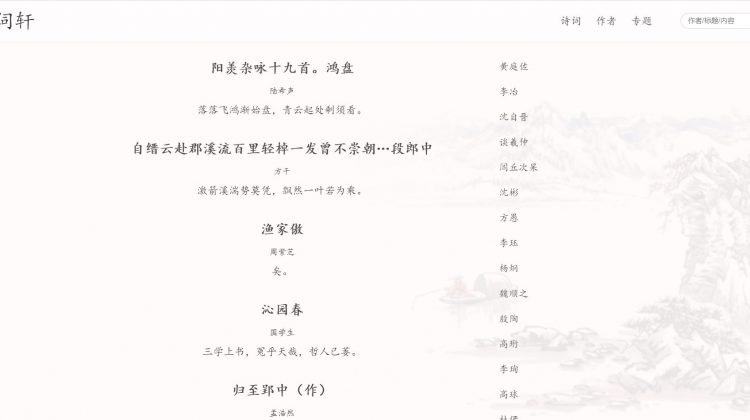Table of Contents
之前有写过用 puppeteer 作为 ssr 解决方案的文章。那个对于旧项目适配很合适,新项目还是一开始就采用 ssr 框架比较好。所以,我把“品词轩”用 nuxt 重新实现了一下。
项目介绍
用 nuxt 实现的诗词网站。功能简单,主要就是为了了解一下 nuxt。(vapper 好像比 nuxt 好用些。)
项目地址:https://github.com/tonyzhou1890/poem-v4-nuxt
网站地址:https://poem-nuxt.tony93.top
实现解析
技术栈
nuxt
Nuxt 简介
nuxt 是基于 vue 的 ssr 框架。方便了 ssr 开发,但也有诸多约束。nuxt 的路由可以是约定式,也可以自定义。约定式路由模式下,pages 下面就是各个页面,layouts 下面是布局。其在 vue 原有的生命周期上添加了 asyncData 和 fetch。asyncData 在页面创建前调用,是阻塞的。所以可以在 asyncData 里请求 api。fetch 是在 created 之后调用,主要用来填充 store 数据,非阻塞。
篇幅有限,就不完整介绍 nuxt 了。反正 nuxt 文档挺长的。
项目结构
/.
│ .editorconfig
│ .eslintrc.js
│ .gitignore
│ .prettierrc
│ ecosystem.config.js // pm2 配置文件
│ jsconfig.json
│ nuxt.config.js // nuxt 配置文件
│ package.json
│ README.md
│ tsconfig.json
│ yarn.lock
│
├─assets // 需要打包引用的资源文件
│ │ global.ts // 这个我随便放的
│ │ README.md
│ │
│ ├─icons
│ │ └─svg
│ │ xxx.svg
│ │
│ ├─images
│ │ background.png
│ │
│ └─style
│ global.less
│ variables.less
│
├─components
│ │ Header.vue
│ │ README.md
│ │
│ ├─Pagination
│ │ index.vue
│ │
│ ├─PoemItemCom
│ │ index.vue
│ │
│ ├─PoemListCom
│ │ index.vue
│ │
│ ├─SvgIcon
│ │ index.vue
│ │
│ └─Tabs
│ index.vue
│
├─layouts
│ default.vue
│ README.md
│
├─middleware
│ README.md
│
├─pages
│ article.vue
│ author.vue
│ authorList.vue
│ collection.vue
│ index.vue
│ poemList.vue
│ README.md
│ search.vue
│ subject.vue
│ subjectPoem.vue
│
├─plugins
│ axios.js
│ icon.js
│ README.md
│ svgo.yml
│
├─services
│ api.ts
│
├─static
│ favicon.ico
│ README.md
│ robots.txt // 练习项目,不需要搜索引擎抓取
│
└─store
index.js
README.md
Axios 的使用
在有 this 的生命周期里,使用 this.$axios,在 asyncData 里使用解构参数里的 $axios。
// pages/index.vue
export default Vue.extend({
name: 'Home',
asyncData({ $axios }) {
return Promise.all([
$axios.get(urls.home, {
params: {
home: true,
},
}),
$axios.get(urls.poemListRandom),
]).then((res) => {
return {
authors: res[0].data.authors,
poems: res[1].data,
}
})
},
data() {
return {
poems: [],
authors: [],
}
},
}
但在使用之前需要配置一下。axios 是作为插件使用的,所以需要在 plugins 文件夹下编写 axios.js 文件。
// plugins/axios.js
export default function ({ app: { $axios } }) {
// 数据访问前缀
$axios.defaults.baseURL = 'https://xxx/xxx'
$axios.interceptors.request.use(
(config) => config,
(error) => {
Promise.reject(error)
}
)
$axios.interceptors.response.use(
(response) => {
if (response.data.code !== 0) {
return Promise.reject(response.data)
} else {
return response.data
}
},
(error) => {
return Promise.reject(error)
}
)
}
// nuxt.config.js
export default {
// Plugins to run before rendering page: https://go.nuxtjs.dev/config-plugins
plugins: ['@/plugins/axios'],
// Modules: https://go.nuxtjs.dev/config-modules
modules: [
// https://go.nuxtjs.dev/axios
'@nuxtjs/axios',
],
// Axios module configuration: https://go.nuxtjs.dev/config-axios
axios: {},
}
Svg-Icon 的封装
为了方便地使用 svg,需要封装一个 svg-icon 组件。
// components/SvgIcon/index.vue
<template>
<svg :class="svgClass" aria-hidden="true">
<use :xlink:href="iconName" />
</svg>
</template>
<script>
export default {
name: 'SvgIcon',
props: {
iconClass: {
type: String,
required: true,
},
className: {
type: String,
default: '',
},
},
computed: {
iconName() {
return `#icon-${this.iconClass}`
},
svgClass() {
if (this.className) {
return 'svg-icon ' + this.className
} else {
return 'svg-icon'
}
},
},
}
</script>
<style scoped>
.svg-icon {
width: 1em;
height: 1em;
vertical-align: -0.15em;
fill: currentColor;
overflow: hidden;
}
</style>
// plugins/icon.js
import Vue from 'vue'
import SvgIcon from '@/components/SvgIcon' // svg组件
// register globally
Vue.component('SvgIcon', SvgIcon)
const req = require.context('@/assets/icons/svg', false, /\.svg$/)
const requireAll = (requireContext) => requireContext.keys().map(requireContext)
requireAll(req)
// nuxt.config.js
import path from 'path'
export default {
// Global CSS: https://go.nuxtjs.dev/config-css
css: ['@/assets/style/variables.less', '@/assets/style/global.less'],
// Plugins to run before rendering page: https://go.nuxtjs.dev/config-plugins
plugins: ['@/plugins/icon', '@/plugins/axios'],
// Build Configuration: https://go.nuxtjs.dev/config-build
build: {
extend(config, _) {
const svgRule = config.module.rules.find((rule) => rule.test.test('.svg'))
svgRule.exclude = [path.resolve(__dirname, 'assets/icons/svg')]
// Includes /assets/icons/svg for svg-sprite-loader
config.module.rules.push({
test: /\.svg$/,
include: [path.resolve(__dirname, 'assets/icons/svg')],
loader: 'svg-sprite-loader',
options: {
symbolId: 'icon-[name]',
},
})
},
},
}
less 的使用和全局样式
安装完 less 和 less-loader 就可以使用 less 了。至于全局样式,创建好文件后 nuxt.config.js 里配置一下就可以了。
// nuxt.config.js
export default {
// Global CSS: https://go.nuxtjs.dev/config-css
css: ['@/assets/style/variables.less', '@/assets/style/global.less'],
}
keep-alive 的使用
因为首页的诗词是随机的,所以首页需要使用 keep-alive 属性,避免每次回到首页都是不一样的内容。
// layouts/default.vue
<Nuxt keep-alive :keep-alive-props="{ include: ['Home'] }" />
include 数组里的组件名称就是组件的 name 属性。如果没写 name,就是 nuxt 自动生成的组件名称。
head 的配置
既然是针对 seo 的改版,metaInfo 自然是需要的。在 nuxt 里,只需要配置页面的 head 属性就可以。
// pages/author.vue
export default Vue.extend({
name: 'Author',
head() {
return {
title: `作者--${this.$route.query.author}`,
meta: [
{
hid: 'description',
name: 'description',
content: `${this.$route.query.author}的诗词`,
},
],
}
},
})
除了各个页面单独配置,最好也设置一个全局的。
// nuxt.config.js
export default {
// Global page headers: https://go.nuxtjs.dev/config-head
head: {
title: '品词轩',
htmlAttrs: {
lang: 'zh',
},
meta: [
{ charset: 'utf-8' },
{ name: 'viewport', content: 'width=device-width, initial-scale=1' },
{ hid: 'description', name: 'description', content: '' },
],
link: [{ rel: 'icon', type: 'image/x-icon', href: '/favicon.ico' }],
},
}
路由参数变化
nuxt 并没有默认根据参数变化重新渲染页面。路由相同的页面,不管参数怎么变,nuxt 都视为同一个页面。这在实际应用中肯定是不合适的。所以,需要打开参数监听——watchQuery。
// nuxt.config.js
export default {
// https://www.nuxtjs.cn/api/pages-watchquery
watchQuery: true,
}
然后,在页面里设置需要监听的参数。
// pages/search.vue
export default Vue.extend({
watchQuery: ['ap', 'tp', 'cp', 'type', 'keyword'],
})
部署
本地开发完后提交 git,然后服务器上拉取项目,安装依赖。然后 yarn build 打包。
我是 nginx + node 的形式。nginx 根据域名代理到 nuxt 服务端口。
按照 nuxt 文档的指引,建立的 ecosystem.config.js 文件,但 pm2 start 启动后怎么也无法访问。用 netstat -tunlp 命令也看不到 3000 端口。
// ecosystem.config.js
module.exports = {
apps: [
{
name: 'NuxtAppName',
exec_mode: 'cluster',
instances: 'max', // Or a number of instances
// script: './node_modules/nuxt/bin/nuxt.js',
script: 'yarn',
args: 'start'
}
]
}
后来我把 script 部分换成 yarn,package.json 里的命令加上端口就好了。
// package.json
"scripts": {
"start": "nuxt-ts start --port 8100",
},
本来以为部署会很顺利,没想到折腾了好久~~~~~~
性能
相比于 puppeteer 方案,nuxt 性能要好很多。在不使用缓存的情况下,浏览器端测试 qps 可以达到 30。配置为 1C2G1M 的 ecs。
总结
相比于传统服务端渲染,nuxt 和 puppeteer 都是首次加载服务端渲染,后续操作客户端渲染。所以虽然性能稍差,但可以满足需求。特别是 nuxt 这一类的方案,其性能优于 puppeteer,结合 redis 一类的内存缓存技术应该可以达到较高的 qps。但 puppeteer 泛用性强,不限定技术栈,并且还可以用于爬虫、海报渲染等场景。所以具体用什么方案还是得看场景。
